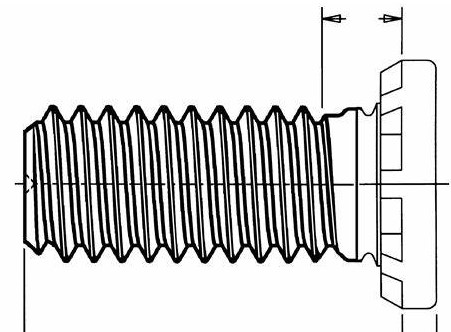Ever struggled with threading projects due to inaccurate measurements? This guide will equip you with the knowledge and tools to measure thread size precisely.
From understanding the basics to troubleshooting common issues, we’ll cover everything you need to create perfect threaded connections.
What is Thread Size?
Thread size is a crucial aspect of threaded components, determining their compatibility and functionality. It’s characterized by three key elements:
➡️Diameter: The distance across the thread’s widest point.
➡️ Pitch: The separation between spots that correspond on neighboring threads.
➡️ Angle: The angle of the thread’s helical shape.
Accurate thread measurement is essential for various reasons, including:
➡️ Ensuring proper fit: Incorrect thread sizes can lead to leaks, misalignment, and reduced performance.
➡️ Identifying compatible parts: Knowing the thread size helps you choose the right components for your project.
➡️ Troubleshooting issues: If a threaded connection is malfunctioning, measuring the threads can help pinpoint the problem.
Tools You’ll Need for Measuring Thread Size
To accurately measure thread size, you’ll need the right tools. Here are some common options:
➡️ Calipers: A versatile tool that can measure both internal and external diameters with precision.
➡️ Thread gauges: Specialized tools with various thread sizes that allow for direct comparison.
➡️ Ruler or tape measure: While not as precise as calipers or gauges, they can be used in a pinch.
Step-by-Step Process to Measure Thread Diameter
Follow this step-by-step process to measure the thread diameter:
1. Identify major and minor diameters: The major diameter is the widest point of the thread, while the minor diameter is the narrowest.
2. Measure external threads (male): Place the caliper jaws over the major and minor diameters to get their measurements.
3. Measure internal threads (female): Insert the caliper jaws into the thread and measure the major and minor diameters.
4. Ensure precision: For accurate results, make sure the caliper jaws are clean and free of debris.
How to Determine Thread Pitch and TPI (Threads Per Inch)
These are the guidelines in determining the thread pitch and thread per inch:
➡️ Understand the difference: Thread pitch is the distance between corresponding points on adjacent threads, while TPI (threads per inch) is the number of threads within one inch.
➡️ Use a thread pitch gauge: This tool has various pitch sizes that can be compared to the thread to determine its pitch.
➡️ Measure TPI without a pitch gauge: Divide one inch by the thread pitch to calculate TPI.
➡️ Avoid common pitfalls: Ensure that you’re measuring the distance between corresponding points on adjacent threads, not the crest or root.
Types of Threads and Their Measurement Differences
➡️ Metric vs. Imperial threads: Metric threads use millimeters for measurements, while Imperial threads use inches.
➡️ NPT vs BSP threads: These are tapered threads commonly used in plumbing applications. NPT threads are tapered in the male part, while BSP threads are tapered in the female part.
➡️ Fine vs Coarse threads: Fine threads have a smaller pitch, while coarse threads have a larger pitch.
Practical Examples of Thread Measurement
➡️ Measuring threads on pipes and fittings: Use calipers to measure the major and minor diameters, and a thread pitch gauge to determine the pitch.
➡️ Measuring threads on bolts and nuts: Measure the diameter and pitch of the threads using calipers and a thread pitch gauge.
➡️ Thread measurement in industrial applications: Accurate thread measurement is crucial in various industries, including manufacturing, construction, and maintenance.
Troubleshooting Common Thread Measurement Issues
➡️ Dealing with worn or damaged threads: If the threads are damaged, it may be difficult to get accurate measurements. Consider using a thread gauge or a microscope.
➡️ How to measure threads with limited access: Use a flexible caliper or a bore gauge to measure threads in tight spaces.
➡️ What to do when threads don’t match standard sizes: If the threads are non-standard, you may need to consult a reference guide or consult with an expert.
FAQs on Measuring Thread Size
Q: How accurate does thread measurement need to be?
A: The application determines the necessary level of accuracy. For critical applications, such as aerospace or medical, extremely precise measurements are essential.
Q: Can I measure threads without a caliper or gauge?
A: While it’s possible to use a ruler or tape measure in a pinch, calipers and gauges provide much more accurate results.
Q: What’s the best way to store and maintain thread measuring tools?
A: Store tools in a clean, dry environment and protect them from damage. Regular cleaning and calibration are also important.
Wrapping Up: Mastering Thread Measurement for Perfect Fits
By following these guidelines and using the appropriate tools, you can accurately measure thread size and ensure proper fit and functionality. Mastering thread measurement can improve efficiency, reduce errors, and enhance the overall quality of your projects.
Post time: Sep-06-2024


